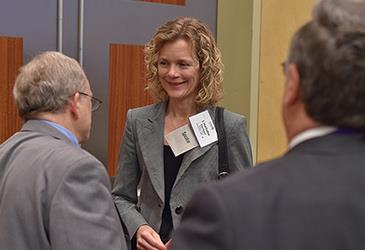Burnout is an all-too-common problem among physicians, but that doesn’t mean the problem isn’t reversible. Here are expert-recommended solutions and wellness strategies to help improve physician satisfaction and resiliency.
Studies have shown that individuals with burnout and depression remain independently associated with liability lawsuits, higher rates of suicidal ideation, depersonalization, medical errors and sub-par patient care, Lotte Dyrbye, MD (pictured below), said during a presentation at the 2015 AMA Annual Meeting.
 Dr. Dyrbye has studied burnout in medical education since 2004 and is a member of the consortium of 11 medical schools that are part of the AMA’s Accelerating Change in Medical Education initiative.
Dr. Dyrbye has studied burnout in medical education since 2004 and is a member of the consortium of 11 medical schools that are part of the AMA’s Accelerating Change in Medical Education initiative.
Dr. Dyrbye urged physicians to understand the key drivers for burnout and then consider a “two-bucket” approach for addressing the issue in practice.
This first bucket of burnout solutions revolves around individual coping strategies physicians can implement to improve self-care and build resiliency, she said.
But solutions in the first bucket have to be paired with ones from the second bucket in order to produce long-term results.
“If you only talk about individual strategies, when you get back to your practice, you’re going to breed cynicism, and that can backfire. So [we have to] combine these personal strategies with discussions about the detrimental aspects of our work environments and wellness programs that will facilitate positive behaviors.”
Bucket No. 1: Taking personal responsibility for self-care, happiness
“Individuals who pursue hobbies and engage in things outside of medicine are not only less likely to develop burnout, but they are more likely to report higher quality of life, so it’s important to schedule that time … for the things that really matter,” Dr. Dyrbye said.
While balancing personal interests with the demands of practice can be difficult, she said even taking just one day a week to pursue a hobby can lower rates of depersonalization and keep physicians from the clenches of cynicism.
Ways to boost your personal well-being include:
- Set time each week to pursue a duty at your practice that you enjoy. “We all have that one thing we like to do at work, whether it involves patient care or something administrative,” Dr. Dyrbye said. “Individuals who find meaning in their work develop a higher sense of satisfaction and are less likely to burn out.”
- Actually take vacations. In previous research, Dr. Dyrbye said she was surprised to find that physicians left multiple days of vacation on their calendars in favor of prioritizing work over personal satisfaction—a practice that can kick burnout into overdrive.
- Maintain a healthy diet and exercise. Dr. Dyrbye noted that physicians who are compliant with the Centers for Disease Control and Prevention’s aerobic guidelines are less likely to have burnout.
- Talk to your spouse. While medical marriages have their benefits, managing the potential stress of two physician workloads can be challenging. However, communication can help minimize work-home conflicts, one of the key drivers of burnout, Dr. Dyrbye said.
- Avoid delayed gratification. This can begin as early as medical school and occurs when physicians routinely deny personal interests—like playing the violin or volunteering at an organization they enjoy—to pursue medicine, Dr. Dyrbye said. Avoid this by finding time for your hobbies now, instead of saving them for retirement.
Bucket No. 2: Establishing an environment of wellness
“There’s something about the work environment for those on the front lines of care, where tasks just seem to be increasing every day,” Dr. Dyrbye said. “And it’s really hard to find meaning in those tasks.”
She recommends that hospitals and practices build supportive communities and wellness programs that meet these parameters:
- Offer honest discussions. “I find that sometimes there may be people who are already attempting wellness solutions, but they’re doing it in isolation,” Dr. Dyrbye said. “The first place any practice can start is by addressing burnout through discussions.” Doing so can help the organization understand how to coordinate efforts and resources.
- Encourage physicians to talk about medical errors. “We know that when doctors talk about medical errors, it can help prevent future errors and reduce inappropriate self-blame and distress,” she said. “Incorporate these discussions into your grand rounds or individual talks in your practice.”
- Build a wellness index or tool to help physicians properly assess their risks for burnout. Despite having the ability to assess patients’ needs, physicians often struggle to assess their own well-being and stress, Dr. Dyrbye said. For instance, in a 2013 study of 1,150 surgeons, surgeons’ personal assessment of well-being relative to colleagues was poor. Among the participants, 89 percent of surgeons believed their well-being was at or above average, including 70.5 percent with scores in the bottom 30 percent relative to national norms. But after receiving objective, individualized feedback based on the Mayo Clinic Physician Well-Being Index score, 46.6 percent of these surgeons indicated that they intended to make specific life changes. Establish a similar survey, tool or wellness index at your practice to help physicians and care staff assess their wellness needs and learn how to seek help.
- Develop flexible schedules. In hospitals and practices that are able, flexible work schedules and systems that facilitate handoffs can alleviate the “exorbitant responsibility to work around all hours,” she said.
Preventing physician burnout is a priority for the AMA’s Professional Satisfaction and Practice Sustainability initiative, which aims to help physicians and their practices thrive so they can continue to put patients first. Stay tuned for more from AMA Wire about tools and approaches to help reduce burnout in your practice.




